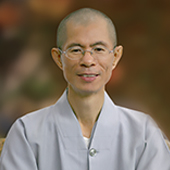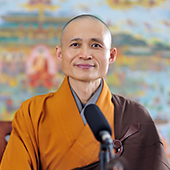The Commentary on the Treatise of Rebirth
The Commentary on the Treatise of Rebirth was written by Master Tanluan, the first patriarch of the Pure Land lineage in China. Master Tanluan’s Commentary on the Treatise of Rebirth is the elaboration and synthesis of Nagarjuna Bodhisattva’s Chapter on the Easy Practice and Vasubandhu Bodhisattva’s Treatise of Rebirth.
Pure Land teaching is the Path of Easy Practice. This Path refers to deliverance through other- power, the power of Amitabha Buddha. It does not refer to how sentient beings like us practice and dedicate merits to Amitabha Buddha, and beg Amitabha Buddha to deliver us. It is not like that.
It is deliverance through other-power, the power of Amitabha Buddha. Our deliverance also requires faith in the teaching and the exclusive practice of Amitabha-recitation. Thus, the Pure Land teaching is round, sudden, simple, and fast.
Every single sentient being like us, has the afflictions of the Five Gravest Transgressions and slandering the Dharma in his mind. Those afflicted ordinary beings can rely on the Easy Path of Amitabha’s deliverance. In this way they can attain Nirvana without cutting off their afflictions and without any change of their status.
So, when we hear that we can rely on Amitabha’s other-power, we should fully entrust ourselves to it, without even the smallest amount of self-generated restrictions. This is the general meaning of the Commentary on the Treatise of Rebirth.
In perceiving the power of the Buddha’s Fundamental Vow, no one who comes across it will fail to be benefitted. It can promptly and fully satisfy us, because it is like a great ocean filled with merits and virtues.
When hearing of “perceiving”, we may think it is a kind of meditative or contemplative observation only achievable by those of the bodhisattva level.
However, if we consider it from the perspective of Amitabha’s Fundamental Vow, this perceiving is not a meditative state of the bodhisattva realm; but, is hearing to believe and contemplating to know Amitabha’s deliverance through his 18th Vow, from the view of ordinary beings. It is also what Master Tanluan explains about perceiving to know and hearing to believe, when the causal conditions to believe are present, one is ready to rely on the Buddha’s vow power.
So, after the explication of the Shastra of Rebirth by Master Tanluan, the true meaning and the true spirit of the Shastra is thoroughly revealed and expounded. If there were no Commentary on the Shastra of Rebirth, it might be neglected and covered up forever.
It is because the Shastra of Rebirth is difficult for us to understand that people may think it is written only for people on the bodhisattva level and not meant for ordinary beings like us.
In the beginning of the Commentary on the Shastra of Rebirth, it talks about the Difficult Path and the Easy Path, and indicates that ordinary beings can rely on the Easy Path. The Easy Path refers to Amitabha’s vow power. Relying on Amitabha’s vow power is like sailing. Once a person is on board, he will reach his destination effortlessly, comfortably, safely and joyfully when the time comes. It is the real meaning of “it can promptly satisfy us in full, because it is a great ocean filled with merits and virtues.”
In the beginning of the Commentary on the Treatise of Rebirth, Master Tanluan briefly interprets Nagarjuna Bodhisattva’s definitions of the Difficult Path and the Easy Path. At the same time, he drew a conclusion that the former path is difficult because “it is merely through self-power, with no other-power to support it”.
What about the Easy Path? What is meant by “easy”? Master Tanluan elaborated, “Just because of the causal condition of believing the Buddha”. This statement is very important!
“Just because” means only. The only condition is “believing the Buddha”. “Believing the Buddha” refers to Amitabha Buddha.
The conclusion of the Commentary on the Treatise of Rebirth, written by Master Tanluan, states “Because of the causal condition of the Buddha’s power, one will naturally attain rebirth as a result of Amitabha-recitation even ten times. “
Thus, we know that Amitabha-recitation even ten times assures the attainment of rebirth with recourse to the Buddha’s vow power. “Practice what we believe” means “with the causal condition of believing the Buddha”. “Not practicing and not believing” means there is no causal condition of believing the Buddha, and no reliance on the Buddha’s vow power, so rebirth is not attained.
In other words, why do sentient beings who recite Amitabha’s Name even ten times attain rebirth? It is because Amitabha-recitation assures the “attainment of rebirth through the causal condition of the Buddha’s power.” Those who are able to believe, should practice this way.
In the Commentary on the Shastra of Rebirth, Master Tanluan said, “All those born in that Pure Land, all practices performed by those bodhisattvas, celestial and human beings are all propelled by Amitabha Tathagata’s Fundamental Vow Power.”
All sentient beings and bodhisattvas born in the Land of Bliss rely on Amitabha’s Vow Power in delivering sentient beings.
Master Tanluan also posed a question. “Why is this so?” He answered, “If it were not for the Buddha’s power, the 48 vows would become useless. “ Without the power of Amitabha Buddha, the 48 vows become void.
Master Tanluan says in the Commentary on the Shastra of Rebirth, “All kinds of human and celestial virtues, and human and celestial rewards and retributions, whether they are cause or effect, all are inverted - upside down, and all are unreal and false. So, they are called unreal virtues.”
The rewards resulting from the Five Precepts and the Ten Wholesome Deeds are regarded as unreal, from the Buddha’s point of view of reality. When we hear these truths they are very stunning!
Generally, when learning Buddhism, it is important to “avoid doing evil and to practice various good deeds”. However, it is said here that all of the virtuous deeds we do are false and unreal. Why?
It is not wrong to say that wholesome rewards is result from wholesome deeds, and unwholesome retributions result from unwholesome deeds. However, whether it is a wholesome reward or an unwholesome retribution, we are unable to liberate ourselves from reincarnation. Thus, ceasing reincarnation and becoming a Buddha is unattainable through the merit and virtues caused by human and celestial karma.
What we pursue today is the end of reincarnation and becoming a Buddha. When pursuing these goals, wholesome karma is false and unreal.
This teaching is always misinterpreted. People think they need not do good things or accumulate virtues. It is not like that. We keep doing good and accumulating virtues in this world, because it is our moral duty and responsibility as a human being, and as a Buddhist. We must do good things in accord with our capacities and our role under the allowable conditions, even though we know they are within the scope of human and celestial rewards.
Guiding Principles
Faith in, and acceptance of, Amitabha’s deliverance
Single-minded recitation of Amitabha’s name
Aspiration to rebirth in Amitabha’s Pure Land
Comprehensive deliverance of all sentient beings


